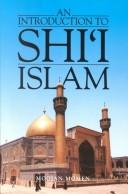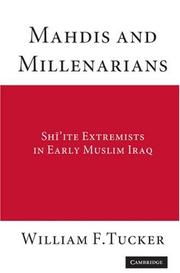| Listing 1 - 10 of 28 | << page >> |
Sort by
|
Book
ISBN: 3534031369 Year: 1988 Publisher: Darmstadt : Wissenschaftliche Buchgesellschaft (WBG),
Abstract | Keywords | Export | Availability | Bookmark
 Loading...
Loading...Choose an application
- Reference Manager
- EndNote
- RefWorks (Direct export to RefWorks)
Shi'ah --- Shīʻah. --- Shīʻah. --- Shīʻah --- Imamites --- Shia --- Shiism --- Twelvers (Islam) --- Islamic sects --- Alids

ISBN: 0300034997 Year: 1985 Publisher: New Haven London Yale University Press
Abstract | Keywords | Export | Availability | Bookmark
 Loading...
Loading...Choose an application
- Reference Manager
- EndNote
- RefWorks (Direct export to RefWorks)
297 --- Shi'ah --- Islam. Mohammedanisme --- Shīʻah. --- Chiisme. --- Sji'isme. --- Shīʻah --- Imamites --- Shia --- Shiism --- Twelvers (Islam) --- Islamic sects --- Alids
Periodical
ISSN: 25887246 25886533 Year: 2011 Publisher: Qum : Bunyād-i Farhangī-i Imāmat,
Abstract | Keywords | Export | Availability | Bookmark
 Loading...
Loading...Choose an application
- Reference Manager
- EndNote
- RefWorks (Direct export to RefWorks)
Book
ISBN: 981501157X 9815011561 Year: 2022 Publisher: Singapore : ISEAS Publishing,
Abstract | Keywords | Export | Availability | Bookmark
 Loading...
Loading...Choose an application
- Reference Manager
- EndNote
- RefWorks (Direct export to RefWorks)
Malaysia was initially lauded for its ability to combat the first few waves of COVID-19 but infection spikes since the Sabah state elections in September 2020 and subsequent exponential increases in both infections and deaths in 2021 left the nation reeling. Nationwide vaccination is seen as the only way out of the pandemic. Malaysia’s COVID-19 communication strategy was hampered by political machinations and myriad changes in government. The need to shore up favour among the electorate resulted in inconsistent messaging and regular U-turns whenever there was public outrage at arbitrary restrictions. This resulted in confusion on the ground, preventing successful COVID-19 management and containment. Under the current regime, claims to more accessible data have been disputed and doubts have surfaced over data transparency and accuracy. There is an urgent need to ensure convincingly reliable information, as well as to use more engaging messaging on more suitable media. A holistic and effective COVID-19 communication strategy should adopt principles from several communication approaches, resulting in messages that are clear, simple and accessible as well as consistent and credible. Audiences should be segmented so that messages can be better tailored to their needs, with adequate information on the necessary steps to prevent infection and spread. Fake news, misinformation, and disinformation should be constantly tackled and debunked. The Gerai OA and OA Lindungi Komuniti Facebook pages are outstanding examples of grassroots information dissemination channels that effectively provide fact-checked, coherent and accessible information to local communities in languages and on media best-suited to their audiences.
Shīʻah --- Sunnites --- Sunni Muslims --- Sunnis --- Islamic sects --- Imamites --- Shia --- Shiism --- Twelvers (Islam) --- Alids --- Relations --- Sunnites. --- Shīʻah.
Multi
ISBN: 9781107625785 9781107031432 9781139381710 1107031435 1107625785 1139381717 1316053911 1316056279 Year: 2014 Publisher: New York (N.Y.): Cambridge university press,
Abstract | Keywords | Export | Availability | Bookmark
 Loading...
Loading...Choose an application
- Reference Manager
- EndNote
- RefWorks (Direct export to RefWorks)
"During the formative period of Islam, in the first centuries after Muḥammad's death, different ideas and beliefs abounded. It was during this period of roughly three centuries that two particular intellectual traditions emerged, Sunnism and Shī;'ism. Sunnī Muslims endorsed the historical caliphate, while Shī'ī; Muslims, supporters of 'Ali, cousin of the Prophet and the fourth caliph, articulated their own distinctive doctrines. The Sunnī-Shī'ī schism is often framed as a dispute over the identity of the successor to Muḥammad, whereas in reality, Sunnī and Shī'ī Muslims also differ on a number of seminal theological doctrines concerning the nature of God and legitimate political and religious authority. This book examines the development of Shī'ī Islam through the lenses of belief, narrative, and memory. In an accessible yet nuanced manner, it conceives of Shī'ism as a historical project undertaken by a segment of the early Muslim community that felt dispossessed. This book also covers, for the first time in English, a wide range of Shī'ī communities from the demographically predominant Twelvers to the transnational Ismā'īlīs to the scholar-activist Zaydīs. The portrait of Shī'ism that emerges is that of a distinctive and vibrant community of Muslims with a remarkable capacity for reinvention and adaptation, grounded in a unique theological interpretation of Islam"--
Islam --- Shīʻah --- History --- Doctrines --- Shīʻah. --- Shīʻah --- 297 --- Imamites --- Shia --- Shiism --- Twelvers (Islam) --- Islamic sects --- Alids --- History. --- Islam. Mohammedanisme --- Doctrines&delete& --- Shīʻah.
Book
ISBN: 131687091X 1316870952 1316650472 1316870995 1316871010 1316871053 1107154081 1316871037 9781316871058 9781316650479 9781316871010 9781316871034 9781107154087 Year: 2017 Publisher: Cambridge : Cambridge University Press,
Abstract | Keywords | Export | Availability | Bookmark
 Loading...
Loading...Choose an application
- Reference Manager
- EndNote
- RefWorks (Direct export to RefWorks)
This book explores the evolution of a Shia Ismaili identity and crucial aspects of the historical forces that conditioned the development of the Muslim modern in late colonial South Asia. It traces the legal process that, since the 1860s, recast a Shia Imami identity for the Ismailis, and explicates the public career of Imam Aga Khan III amid heightened religious internationalism since the late-nineteenth century, the age of 'religious internationals'. It sheds light and elaborates on the enduring legacies of questions such as the Aga's understanding of colonial modernity, his ideas of India, restructured modalities of community governance and the evolution of Imamate-sponsored institutions, key strands in scholarship that characterized the development of the Muslim and Shia Ismaili modern, and Muslim universality vis-à-vis denominational particularities that often transcended the remits of the modular nation and state structure.
Ismailites --- Shīʻah --- Shiites --- Shia Muslims --- Shiah Muslims --- Shiahs --- Shias --- Shiite Muslims --- Muslims --- Ismailians --- Ismailis --- Assassins (Ismailites) --- Imamites --- Shia --- Shiism --- Twelvers (Islam) --- Islamic sects --- Alids
Book

ISBN: 9791097093556 9791097093181 Year: 2022 Publisher: Marseille, Paris : Diacritiques Éditions,
Abstract | Keywords | Export | Availability | Bookmark
 Loading...
Loading...Choose an application
- Reference Manager
- EndNote
- RefWorks (Direct export to RefWorks)
Évoquer les minorités en Islam, c’est penser immédiatement aux minorités religieuses non musulmanes en pays majoritairement musulman et tout particulièrement à celles qui ont bénéficié du statut de dhimmi, de « tributaire ». Ce recueil propose un déplacement du regard sur la notion de minorités en l’interrogeant à la fois du point de vue de l’histoire et du politique. Il sera tout autant question ici des musulmans en Europe ou en Chine que des minorités présentes dans les pays d’Islam, qu’il s’agisse de minorités confessionnelles ou sociétales regroupées autour d’affinités politiques, idéologiques, religieuses ou de genre.
Religion --- alaouites --- chiisme --- chrétiens --- féminisme islamique --- homosexualité --- imamisme --- islam --- ismaélisme --- musulmans chinois --- sunnisme --- Alawites --- Shiism --- China --- Christians --- Islamic feminism --- homosexuality --- Imamism --- Islam --- Ismailism --- Chinese Muslims --- Sunnism --- gender
Multi
ISBN: 9781107424951 9781107010710 9780511862618 9781139128636 1139128639 1139115804 9781139115803 1107010713 9781139115803 1107228646 1139125133 1283316404 1139123726 9786613316400 1139113615 1139117971 051186261X 110742495X Year: 2011 Publisher: New York : Cambridge University Press,
Abstract | Keywords | Export | Availability | Bookmark
 Loading...
Loading...Choose an application
- Reference Manager
- EndNote
- RefWorks (Direct export to RefWorks)
The Sunni-Shi'a schism is often framed as a dispute over the identity of the successor to Muhammad. In reality, however, this fracture only materialized a century later in the important southern Iraqi city of Kufa (present-day Najaf). This book explores the birth and development of Shi'i identity. Through a critical analysis of legal texts, whose provenance has only recently been confirmed, the study shows how the early Shi'a carved out independent religious and social identities through specific ritual practices and within separate sacred spaces. In this way, the book addresses two seminal controversies in the study of early Islam, namely the dating of Kufan Shi'i identity and the means by which the Shi'a differentiated themselves from mainstream Kufan society. This is an important, original and path-breaking book that marks a significant development in the study of early Islamic society.
Islam --- History of civilization --- anno 1700-1799 --- Iraq --- Kūfah (Iraq) --- Shīʻah --- Shīʻah --- History. --- Religion. --- Imamites --- Shia --- Shiism --- Twelvers (Islam) --- Islamic sects --- Alids --- Kūfah (Iraq) --- Kūfa (Iraq) --- Arts and Humanities --- History --- Shiah --- Kufah (Iraq)

ISBN: 9780521883849 0521883849 9780511512094 9780521178372 9786611156121 6611156127 0511370954 9780511370953 9780511371424 051137142X 9780511369421 0511369425 9780511370441 051137044X 0511512090 1281156124 9781281156129 1107185971 0511369948 0521178371 Year: 2008 Publisher: Cambridge ; New York : Cambridge University Press,
Abstract | Keywords | Export | Availability | Bookmark
 Loading...
Loading...Choose an application
- Reference Manager
- EndNote
- RefWorks (Direct export to RefWorks)
Mahdis and Millenarians is a discussion of Shiite groups in eighth- and ninth-century Iraq and Iran, whose ideas reflected a mixture of indigenous non-Muslim religious teachings and practices in Iraq in the early centuries of Islamic rule. It demonstrates the period's fluidity of religious boundaries. Particular attention is given to the millenarian expectations and the revolutionary political activities of these sects. Specifically, it seeks to define the term 'millenarian', to explain how these groups reflect that definition, and to show how they need to be seen in a much larger context than Shiite or even Muslim history. The author concentrates, therefore, on the historical-sociological role of these movements. The thesis of the study is that they were the first revolutionary chiliastic groups in Islamic history and, combined with the later influence of some of their doctrines, contributed to the teachings of a number of subsequent Shiite or quasi-Shiite sectarian groups.
Shīʻah --- Islam --- Islamic fundamentalism --- Chiisme --- Intégrisme islamique --- History. --- Histoire --- Fundamentalism, Islamic --- Islamism --- Religious fundamentalism --- Mohammedanism --- Muhammadanism --- Muslimism --- Mussulmanism --- Religions --- Muslims --- Imamites --- Shia --- Shiism --- Twelvers (Islam) --- Islamic sects --- Alids --- Arts and Humanities --- History --- Shiah
Book
ISBN: 9781107411432 9780521765848 9780511676413 9780511677380 0511677383 0511681879 9780511681875 9786612536250 661253625X 9780511678646 0511678649 0521765846 0511739680 1107208815 1282536257 0511683855 0511676417 0511679890 1107411432 Year: 2010 Publisher: Cambridge ; New York : Cambridge University Press,
Abstract | Keywords | Export | Availability | Bookmark
 Loading...
Loading...Choose an application
- Reference Manager
- EndNote
- RefWorks (Direct export to RefWorks)
The Shiites of Lebanon under Ottoman Rule provides an original perspective on the history of the Shiites as a constituent of Lebanese society. Winter presents a history of the community before the 19th century, based primarily on Ottoman Turkish documents. From these, he examines how local Shiites were well integrated in the Ottoman system of rule, and that Lebanon as an autonomous entity only developed in the course of the 18th century through the marginalization and then violent elimination of the indigenous Shiite leaderships by an increasingly powerful Druze-Maronite emirate. As such the book recovers the Ottoman-era history of a group which has always been neglected in chronicle-based works, and in doing so, fundamentally calls into question the historic place within 'Lebanon' of what has today become the country's largest and most activist sectarian community.
Islam --- History of Asia --- anno 1500-1799 --- Lebanon --- Shīʻah --- Shiites --- Imamites --- Shia --- Shiism --- Twelvers (Islam) --- Islamic sects --- Alids --- History. --- Political activity --- Politics and government. --- Ethnic relations. --- Geschichte 1516-1788 --- Arts and Humanities --- History --- Shiah
| Listing 1 - 10 of 28 | << page >> |
Sort by
|

 Search
Search Feedback
Feedback About UniCat
About UniCat  Help
Help News
News